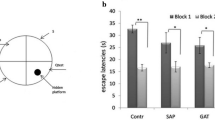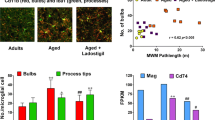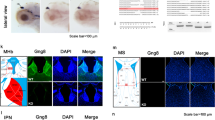Abstract
The hippocampus, which provides cognitive functions, has been shown to become highly vulnerable during aging. One important modulator of the hippocampal neural network is the medial septum (MS). The present study attempts to determine how age-related mnemonic dysfunction is associated with neurochemical changes in the septohippocampal (SH) system, using behavioral and immunochemical experiments performed on young-adult, middle-aged and aged rats. According to these behavioral results, the aged and around 52.8% of middle-aged rats (within the “middle-aged-impaired” sub-group) showed both impaired spatial reference memory in the Morris water maze and habituation in the open field. Immunohistochemical studies revealed a significant decrease in the number of MS choline acetyltransferase immunoreactive cells in the aged and all middle-aged rats, in comparison to the young; however the number of gamma-aminobutyric acid-ergic (GABAergic) parvalbumin immunoreactive cells was higher in middle-aged-impaired and older rats compared to young and middle-aged-unimpaired rats. Western Blot analysis moreover showed a decrease in the level of expression of cholinergic, GABAergic and glutamatergic receptors in the hippocampus of middle-aged-impaired and aged rats in contrast to middle-aged-unimpaired and young rats. The present results demonstrate for the first time that a decrease in the expression level of hippocampal receptors in naturally aged rats with impaired cognitive abilities occurs in parallel with an increase in the number of GABAergic neurons in the MS, and it highlights the particular importance of inhibitory signaling in the SH network for memory function.










Similar content being viewed by others
Availability of data and material
All primary data are provided in Supplementary Materials-2.
Code availability
Not applicable.
References
Aggleton JP, Albasser MM, Aggleton DJ, Poirier GL, Pearce JM (2010) Lesions of the rat perirhinal cortex spare the acquisition of a complex configural visual discrimination yet impair object recognition. Behav Neurosci 124(1):55–68. https://doi.org/10.1037/a0018320
Albert-Gascó H, Ma S, Ros-Bernal F, Sánchez-Pérez AM, Gundlach AL, Olucha-Bordonau FE (2018) GABAergic neurons in the rat medial septal complex express relaxin-3 receptor (RXFP3) mRNA. Front Neuroanat 17(11):133. https://doi.org/10.3389/fnana.2017.00133
Bañuelos C, LaSarge CL, McQuail JA, Hartman JJ, Gilbert RJ, Ormerod BK, Bizon JL (2013) Age-related changes in rostral basal forebrain cholinergic and GABAergic projection neurons: relationship with spatial impairment. Neurobiol Aging 34(3):845–862. https://doi.org/10.1016/j.neurobiolaging.2012.06.013
Bassant MH, Simon A, Poindessous-Jazat F, Csaba Z, Epelbaum J, Dournaud P (2005) Medial septal GABAergic neurons express the somatostatin sst2A receptor: functional consequences on unit firing and hippocampal theta. J Neurosci 25:2032–2041. https://doi.org/10.1523/JNEUROSCI.4619-04.2005
Bolivar V, Flaherty L (2003) A region on chromosome 15 controls intersession habituation in mice. J Neurosci 23:9435–9438. https://doi.org/10.1523/JNEUROSCI.23-28-09435.2003
Bonifazi P, Erramuzpe A, Diez I, Gabilondo I, Boisgontier MP, Pauwels L, Stramaglia S, Swinnen SP, Cortes JM (2018) Structure-function multi-scale connectomics reveals a major role of the fronto-striato-thalamic circuit in brain aging. Hum Brain Mapp 39(12):4663–4677. https://doi.org/10.1002/hbm.24312
Borhegyi Z, Varga V, Szilágyi N, Fabo D, Freund TF (2004) Phase segregation of medial septal GABAergic neurons during hippocampal theta activity. J Neurosci 24:8470–8479. https://doi.org/10.1523/JNEUROSCI.1413-04.2004
Buzsaki G (2002) Theta oscillations in the hippocampus. Neuron 33:325–340. https://doi.org/10.1016/S0896-6273(02)00586-X
Cai L, Gibbs RB, Johnson DA (2012) Recognition of novel objects and their location in rats with selective cholinergic lesion of the medial septum. Neurosci Lett 506:261–265. https://doi.org/10.1016/j.neulet.2011.11.019
Chawla MK, Barnes CA (2007) Hippocampal granule cells in normal aging: insights from electrophysiological and functional imaging experiments. Prog Brain Res 163:661–678. https://doi.org/10.1016/S0079-6123(07)63036-2 (review)
Cheng Q, Yakel JL (2015) The efect of α7 nicotinic receptor activation on glutamatergic transmission in the hippocampus. Biochem Pharmacol 97:439–444. https://doi.org/10.1016/j.bcp.2015.07.015
da Costa JP, Vitorino R, Silva GM, Vogel C, Duarte AC, Rocha-Santos TA (2016) A synopsis on aging—theories, mechanisms and future prospects. Ageing Res Rev 29:90–112. https://doi.org/10.1016/j.arr.2016.06.005
Dashniani MG, Burjanadze MA, Naneishvili TL, Chkhikvishvili NC, Beselia GV, Kruashvili LB, Pochkhidze NO, Chighladze MR (2015) Exploratory behavior and recognition memory in medial septal electrolytic, neuro- and immunotoxic lesioned rats. Physiol Res 5(64):755–767. https://doi.org/10.33549/physiolres.932809
Dashniani MG, Burjanadze MA, Chkhikvishvili NC, Solomonia RO, Kandashvili M, Naneishvili TL, Beselia GV, Kruashvili LB, Chighladze MR (2020) Modulation of spatial memory and expression of hippocampal neurotransmitter receptors by selective lesion of medial septal cholinergic and GABAergic neurons. Exp Brain Res 238:2385–2397. https://doi.org/10.1007/s00221-020-05889-6
Dwyer TA, Servatius RJ, Pang KC (2007) Noncholinergic lesions of the medial septum impair sequential learning of different spatial locations. J Neurosci 27:299–303. https://doi.org/10.1523/JNEUROSCI.4189-06.2007
Fadda F, Cocco S, Stancampiano R (2000) Hippocampal acetylcholine release correlates with spatial learning performance in freely moving rats. NeuroReport 11(10):2265–2269. https://doi.org/10.1097/00001756-200007140-00040
Fitz NF, Gibbs RB, Johnson DA (2008) Selective lesion of septal cholinergic neurons in rats impairs acquisition of a delayed matching to position T-maze task by delaying the shift from a response to a place strategy. Brain Res Bull 77:356–360. https://doi.org/10.1016/j.brainresbull.2008.08.016
Foster TC, DeFazio RA, Bizon JL (2012) Characterizing cognitive aging of spatial and contextual memory in animal models. Front Aging Neurosci 4:12. https://doi.org/10.3389/fnagi.2012.00012
Fragkouli A, Hearn C, Errington M, Cooke S, Grigoriou M, Bliss T, Stylianopoulou F, Pachnis V (2005) Loss of forebrain cholinergic neurons and impairment in spatial learning and memory in LHX7- deficient mice. Eur J Neurosci 21(11):2923–2938. https://doi.org/10.1111/j.1460-9568.2005.04141.x
Freund TF, Antal M (1988) GABA-containing neurons in the septum control inhibitory interneurons in the hippocampus. Nature 336:170–173. https://doi.org/10.1038/336170a0
Gangadharan G, Shin J, Kim SW, Kim A, Paydar A, Kim DS, Miyazaki T, Watanabe M, Yanagawa Y, Kim J, Kim Y, Kim D, Shin H (2016) Medial septal GABAergic projection neurons promote object exploration behavior and type 2 theta rhythm. Proc Natl Acad Sci USA 113:6550–6555. https://doi.org/10.1073/pnas.1605019113
Garceza ML, de Carvalhoa CA, Minaa F, Bellettini-Santosa T, Schiavoa GL, da Silvaa S, Falchetti B, Camposa AC, Varelab RB, Valvassorib SS, Damianic AP, Longarettic LM, de Andradec VM, Budnia J (2018) Sodium butyrate improves memory and modulates the activity of histone deacetylases in aged rats after the administration of d-galactose. Exp Gerontol 113:209–217. https://doi.org/10.1016/j.exger.2018.10.005
Ge Y, Dong Z, Bagot RC, Howland JG, Phillips AG, Wong TP, Wang YT (2010) Hippocampal long-term depression is required for the consolidation of spatial memory. Proc Natl Acad Sci USA 107:16697–16702. https://doi.org/10.1073/pnas.1008200107
Ghafari M, Falsaf SK, Szodorai E, Kim EJ, Li L, Hoger H, Berger J, Fuchs K, Sieghart W, Lubec G (2017) Formation of GABAA receptor complexes containing alpha1 and alpha5 subunits is paralleling a multiple T-maze learning task in mice. Brain Struct Funct 222(1):549–561. https://doi.org/10.1007/s00429-016-1233-x
Givens BS, Olton DS (1990) Cholinergic and GABAergic modulation of medial septal area: effect on working memory. Behav Neurosci 104:849–855. https://doi.org/10.1037/0735-7044.104.6.849
Gonzalez-Sulser A, Parthier D, Candela A, McClure C, Pastoll H, Garden D, Surmeli G, Nolan MF (2014) GABAergic projections from the medial septum selectively inhibit interneurons in the medial entorhinal cortex. J Neurosci 34:16739–16743. https://doi.org/10.1523/JNEUROSCI.1612-14.2014
Gu Z, Yakel JL (2011) Timing-dependent septal cholinergic induction of dynamic hippocampal synaptic plasticity. Neuron 71:155–165. https://doi.org/10.1016/j.neuron.2011.04.026
Guerra-Gomes S, Viana JM, Nascimento DSM, Correia JS, Sardinha VM, Caetano I, Sousa N, Pinto L, Oliveira JF (2018) The role of astrocytic calcium signaling in the aged prefrontal cortex. Front Cell Neurosci 5(12):379. https://doi.org/10.3389/fncel.2018.00379
Gulyas AI, Hajos N, Katona I, Freund TF (2003) Interneurons are the local targets of hippocampal inhibitory cells which project to the medial septum. Eur J Neurosci 17:1861–1872. https://doi.org/10.1046/j.1460-9568.2003.02630.x
Hamezah HS, Durani LW, Ibrahim NF, Yanagisawa D, Kato T, Shiino A, Tanaka S, Damanhuri HA, Ngah WZ, Tooyama I (2017) Volumetric changes in the aging rat brain and its impact on cognitive and locomotor functions. Exp Gerontol 1(99):69–79. https://doi.org/10.1016/j.exger.2017.09.008
Hangya B, Borhegyi Z, Szilágyi N, Freund TF, Varga V (2009) GABAergic neurons of the medial septum lead the hippocampal network during theta activity. J Neurosci 29:8094–8102. https://doi.org/10.1523/JNEUROSCI.5665-08.2009
Kakegawa W, Tsuzuki K, Yoshida Y, Kameyama K, Ozawa S (2004) Input- and subunit-specifc AMPA receptor trafcking underlying long-term potentiation at hippocampal CA3 synapses. Eur J Neurosci 20(1):101–110. https://doi.org/10.1111/j.1460-9568.2004.03461.x
Kanju PM, Parameshwaran K, Sims-Robinson C, Uthayathas S, Josephson EM, Rajakumar N, Dhanasekaran M, Suppiramaniam V (2012) Selective cholinergic depletion in medial septum leads to impaired long term potentiation and glutamatergic synaptic currents in the hippocampus. PLoS ONE 7:e31073. https://doi.org/10.1371/journal.pone.0031073
Kelly KM, Nadon NL, Morrison JH, Thibault O, Barnes CA, Blalock EM (2006) The neurobiology of aging. Epilepsy Res 68S:S5–S20. https://doi.org/10.1016/j.eplepsyres.2005.07.015
Kroker KS, Rast G, Rosebrock H (2011) Differential effects of subtype-specific nicotinic acetylcholine receptor agonists on early and late hippocampal LTP. Eur J Pharmacol 671(1–3):26–32. https://doi.org/10.1016/j.ejphar.2011.09.167
Lecourtier L, de Vasconcelos AP, Leroux E, Cosquer B, Geiger K, Lithfous S, Cassel J (2011) Septohippocampal pathways contribute to system consolidation of a spatial memory: sequential implication of GABAergic and cholinergic neurons. Hippocampus 21:1277–1289. https://doi.org/10.1002/hipo.20837
Lee I, Hunsaker MR, Kesner RP (2005) The role of hippocampal subregions in detecting spatial novelty. Behav Neurosci 119:145–153. https://doi.org/10.1037/0735-7044.119.1.145
Liu A, Jain N, Vyas A, Lim LW (2015) Ventromedial prefrontal cortex stimulation enhances memory and hippocampal neurogenesis in the middle-aged rats. Elife 4:e04803. https://doi.org/10.7554/eLife.04803
MacQueen J (1967) Some methods for classification and analysis of multivariate observations. In: Proceedings of the fifth Berkeley symposium on mathematical statistics and probability, vol 14, pp 281–29
Manrique T, Moron I, Ballesteros MA, Guerrero RM, Gallo M (2007) Hippocampus, ageing, and taste memories. Chem Senses 32:111–117. https://doi.org/10.1093/chemse/bjl042
Manseau F, Goutagny R, Danik M, Williams S (2008) The hippocamposeptal pathway generates rhythmic firing of GABAergic neurons in the medial septum and diagonal bands: an investigation using a complete septohippocampal preparation in vitro. J Neurosci 28(15):4096–4107. https://doi.org/10.1523/JNEUROSCI.0247-08.2008
Martín-Belmonte A, Aguado C, Alfaro-Ruíz R, Moreno-Martínez AE, de la Ossa L, Martínez-Hernández J et al (2019) Reduction in the neuronal surface of post- and pre-synaptic GABA B receptors in the hippocampus in a mouse model of Alzheimer’s disease. Brain Pathol 30:554–575. https://doi.org/10.1111/bpa.12802
Martín-Belmonte A, Aguado C, Alfaro-Ruíz R, Itakura M, Moreno-Martínez AE, de la Ossa L, Molnár E, Fukazawa Y, Luján R (2020) Age-dependent shift of AMPA receptors from synapses to intracellular compartments in alzheimer’s disease: immunocytochemical analysis of the CA1 hippocampal region in APP/PS1 transgenic mouse model. Front Aging Neurosci. https://doi.org/10.3389/fnagi.2020.577996
Martín-Belmonte A, Aguado C, Alfaro-Ruíz R, Albasanz JL, Martín M, Moreno-Martínez AE, Fukazawa Y, Luján R (2021) The density of group I mGlu5 receptors is reduced along the neuronal surface of hippocampal cells in a mouse model of Alzheimer’s disease. Int J Mol Sci 22(11):5867. https://doi.org/10.3390/ijms22115867
McQuail JA, Riddle DR, Nicolle MM (2011) Neuroinflammation not associated with cholinergic degeneration in aged-impaired brain. Neurobiol Aging 32(12):2322, e1-4. https://doi.org/10.1016/j.neurobiolaging.2010.05.012
Moodley KK, Chan D (2014) The hippocampus in neurodegenerative disease. Front Neurol Neurosci 34:95–108. https://doi.org/10.1159/000356430
Morris RG, Garrud P, Rawlins JN, O’Keefe J (1982) Place navigation impaired in rats with hippocampal lesions. Nature 297(5868):681–683. https://doi.org/10.1038/297681a0
Morrison JH, Baxter MG (2012) The ageing cortical synapse: hallmarks and implications for cognitive decline. Nat Rev Neurosci 13:240–250. https://doi.org/10.1038/nrn3200
Nathan PJ, Watson J, Lund J, Davies CH, Peters G, Dodds CM, Swirski B, Lawrence P, Bentley GD, O’Neill BV, Robertson J, Watson S, Jones GA, Maruff P, Croft RJ, Laruelle M, Bullmore ET (2013) The potent M1 receptor allosteric agonist GSK1034702 improves episodic memory in humans in the nicotine abstinence model of cognitive dysfunction. Int J Neuropsychopharmacol 16:721–731. https://doi.org/10.1017/S1461145712000752
Okada K, Nishizawa K, Kobayashi T, Sakata S, Kobayashi K (2015) Distinct roles of basal forebrain cholinergic neurons in spatial and object recognition memory. Sci Rep 5:13158. https://doi.org/10.1038/srep13158
Paban V, Jaffard M, Chambon C, Malafosse M, Alescio-Lautier B (2005) Time course of behavioral changes following basal forebrain cholinergic damage in rats: environmental enrichment as a therapeutic intervention. Neuroscience 132:13–32. https://doi.org/10.1016/j.neuroscience.2004.11.024
Pang KC, Jiao X, Sinha S, Beck KD, Servatius RJ (2011) Damage of GABAergic neurons in the medial septum impairs spatial working memory and extinction of active avoidance: effects on proactive interference. Hippocampus 21:835–846. https://doi.org/10.1002/hipo.20799
Peterson GM, Shurlow CL (1992) Morphological evidence for a substance P projection from medial septum to hippocampus. Peptides 13(3):509–517. https://doi.org/10.1016/0196-9781(92)90082-e
R Development Core Team (2016) R: a language and environment for statistical computing. R Found. Stat. Comput. http://www.r-project.org
Roland JJ, Savage LM (2009) The role of cholinergic and GABAergic medial septal/diagonal band cell populations in the emergence of diencephalic amnesia. Neuroscience 160(1):32–41. https://doi.org/10.1016/j.neuroscience.2009.02.044
Roland JJ, Stewart AL, Janke KL, Gielow MR, Kostek JA, Savage LM, Servatius RJ, Pang KCH (2014) Medial septum-diagonal band of Broca (MSDB) GABAergic regulation of hippocampal acetylcholine efflux is dependent on cognitive demands. J Neurosci 34:506–514. https://doi.org/10.1523/JNEUROSCI.2352-13.2014
Rosenzweig ES, Barnes CA (2003) Impact of aging on hippocampal function: plasticity, network dynamics, and cognition. Prog Neurobiol 69:143–179. https://doi.org/10.1016/S0301-0082(02)00126-0
Rubio SE, Vega-Flores G, Martinez A, Bosch C, Perez-Mediavilla A, del Rio J, Gruart A, Delgado-Garcia JM, Soriano E, Pascual M (2012) Accelerated aging of the GABAergic septohippocampal pathway and decreased hippocampal rhythms in a mouse model of Alzheimer’s disease. FASEB J 26(11):4458–4467. https://doi.org/10.1096/fj.12-208413
Rye DB, Wainer BH, Mesulam MM, Mufson EJ, Saper CB (1984) Cortical projections arising from the basal forebrain: a study of cholinergic and noncholinergic components employing combined retrograde tracing and immunohistochemical localization of choline acetyltransferase. Neurosci 13(3):627–643. https://doi.org/10.1016/0306-4522(84)90083-6
Sadigh-Eteghad S, Majdi A, Talebi M, Mahmoudi J, Babri S (2015) Regulation of nicotinic acetylcholine receptors in Alzheimers disease: a possible role of chaperones. Eur J Pharmacol 755:34–41. https://doi.org/10.1016/j.ejphar.2015.02.047
Serrano-Pozo A, Frosch MP, Masliah E, Hyman BT (2011) Neuropathological alterations in Alzheimer disease. Cold Spring Harb Perspect Med 1:a006189. https://doi.org/10.1101/cshperspect.a006189
Sotty F, Danik M, Manseu F, Laplante F, Quirion R, Williams S (2003) Distinct electrophysiological properties of glutamatergic, cholinergic and GABAergic septohippocampal neurons: novel implications for hippocampal rhythmicity. J Physiol 551:927–943. https://doi.org/10.1113/jphysiol.2003.046847
Taridi NM, Rani NA, Latiff AA, Ngah WZ, Mazlan M (2014) Tocotrienol rich fraction reverses age-related deficits in spatial learning and memory in aged rats. Lipids 49(9):855–869. https://doi.org/10.1007/s11745-014-3919-2
Toth K, Borhegyi Z, Freund TF (1993) Postsynaptic targets of GABAergic hippocampal neurons in the medial septum-diagonal band of Broca complex. J Neurosci 13:3712–3724. https://doi.org/10.1523/jneurosci.13-09-03712.1993
Wilson IA, Ikonen S, Gallagher M, Eichenbaum H, Tanila H (2005) Age-associated alterations of hippocampal place cells are subregion specific. J Neurosci. https://doi.org/10.1523/JNEUROSCI.1744-05.2005
Winters BD, Dunnett SB (2004) Selective lesioning of the cholinergic septo-hippocampal pathway does not disrupt spatial short-term memory: a comparison with the effects of fimbria-fornix lesions. Behav Neurosci 118:546–562. https://doi.org/10.1037/0735-7044.118.3.546
Ypsilanti AR, da Cruz GMT, Burgess A, Aubert I (2008) The length of hippocampal cholinergic fibers is reduced in the aging brain. Neurobiol Aging 29(11):1666–1679. https://doi.org/10.1016/j.neurobiolaging.2007.04.001
Yuan M, Meyer T, Benkowitz C, Savanthrapadian S, Ansel-Bollepalli L, Foggetti A, Wulff P, Alcam P, Elgueta C, Bartos M (2017) Somatostatin-positive interneurons in the dentate gyrus of mice provide local- and long-range septal synaptic inhibition. Elife 6:e21105. https://doi.org/10.7554/eLife.21105
Acknowledgements
Not applicable.
Funding
The design of this study, analysis, interpretation of data and writing the manuscript was supported by the funding from the Shota Rustaveli National Science Foundation of Georgia (SRNSFG): Grant—# FR-18-11783.
Author information
Authors and Affiliations
Contributions
MB and MD contributed to conception and design; MB, MD, VL and RS contributed to analysis and interpretation of data in the manuscript; GB, LK, NC, MC, and LT managed the data collection. Statistical analysis was done by MB, RS and VL. RS and TN revised the manuscript; all authors agreed to be accountable for all aspects of the work. All authors read and approved the final manuscript.
Corresponding author
Ethics declarations
Conflict of interest
The authors declare that there are no conflicts of interest regarding the publication of this paper.
Ethics approval
All experimental procedures were conducted in accordance with the European Communities Council Directive Guidelines for the care and use of Laboratory animals (2010/63/EU—European Commission) and approved by the animal care and use committee at the I. Beritashvili Center of Experimental Biomedicine.
Consent for publication
All co-authors have agreed to the submission of final manuscript.
Additional information
Communicated by Sreedharan Sajikumar.
Publisher's Note
Springer Nature remains neutral with regard to jurisdictional claims in published maps and institutional affiliations.
Supplementary Information
Below is the link to the electronic supplementary material.
Rights and permissions
About this article
Cite this article
Burjanadze, M.A., Dashniani, M.G., Solomonia, R.O. et al. Age-related changes in medial septal cholinergic and GABAergic projection neurons and hippocampal neurotransmitter receptors: relationship with memory impairment. Exp Brain Res 240, 1589–1604 (2022). https://doi.org/10.1007/s00221-022-06354-2
Received:
Accepted:
Published:
Issue Date:
DOI: https://doi.org/10.1007/s00221-022-06354-2




